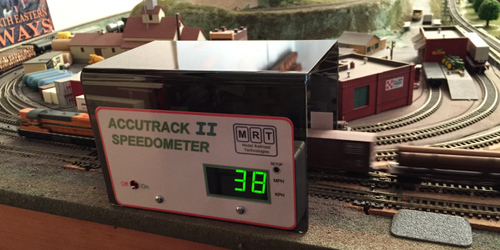D&J RailRoad
Professor of HO
I've done quite a bit of speed matching locomotives over my time and was thinking, there has to be a better/easier way.
I'm sure technology is there to design and fabricate something that can do this.
Prolly along the lines of a locomotive test stand where the loco is mounted on rollers so the wheels can turn while on the stand.
A speed matching device would have two stands with rollers.
The first one, we'll call the base unit, holds the loco that you want all other locomotives to match to.
The second stand holds the locomotive that you want to adjust the speed of to match the loco in the base unit.
Both stands are electronically linked for comparison of the speed of rotation of one of the wheel rollers on each stand.
The second stand is linked to a computer that is running JMRI decoder pro or the ESU LokProgrammer. The speed table tab is activated so the speed of the second loco can be adjusted to the base loco.
The speed steps are set to 128 and the programming is activated. The computer starts with speed step one and compares the second loco to the base loco and adjusts the roller speed to match the base loco. When they match, the program makes an entry in the speed table in JMRI then goes on to speed step two, doing the same thing again until both speed steps 2 match. After it goes through the complete table, the locos are perfectly matched. It wouldn't matter if momentum is turned on or not because it's the stabilized speed that is being compared. Momentum could be applied later. I'm not sure how it could be applied in this same fashion.
It doesn't matter what brand or type decoder is in the base loco because only the speed of the rollers is being monitored.
Thoughts, suggestions, cat calls........?
I'm sure technology is there to design and fabricate something that can do this.
Prolly along the lines of a locomotive test stand where the loco is mounted on rollers so the wheels can turn while on the stand.
A speed matching device would have two stands with rollers.
The first one, we'll call the base unit, holds the loco that you want all other locomotives to match to.
The second stand holds the locomotive that you want to adjust the speed of to match the loco in the base unit.
Both stands are electronically linked for comparison of the speed of rotation of one of the wheel rollers on each stand.
The second stand is linked to a computer that is running JMRI decoder pro or the ESU LokProgrammer. The speed table tab is activated so the speed of the second loco can be adjusted to the base loco.
The speed steps are set to 128 and the programming is activated. The computer starts with speed step one and compares the second loco to the base loco and adjusts the roller speed to match the base loco. When they match, the program makes an entry in the speed table in JMRI then goes on to speed step two, doing the same thing again until both speed steps 2 match. After it goes through the complete table, the locos are perfectly matched. It wouldn't matter if momentum is turned on or not because it's the stabilized speed that is being compared. Momentum could be applied later. I'm not sure how it could be applied in this same fashion.
It doesn't matter what brand or type decoder is in the base loco because only the speed of the rollers is being monitored.
Thoughts, suggestions, cat calls........?


